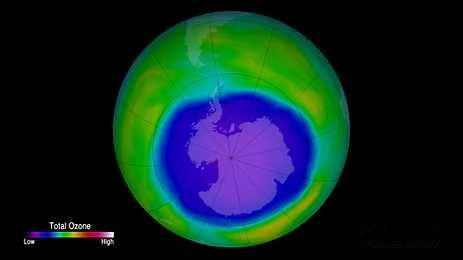Cool Sound Industries, Inc.
Advanced technology for Air-conditioning & Heating
"We harness the power of sound" ™
Phone 561-707-1633 info@CoolSound.net
The Earth's Ozone Layer

The largest ozone hole ever seen has opened up over Antarctica, a sign that ozone-depleting gases churned out years ago are just now coming to their peak, NASA scientists reported October 2, 2015. Seen in this image released by the National Aeronautics and Space Administration, the hole appears as a giant blue blob which spreads over about 11 million square miles (28.3 million square kilometers) This color in blue you see here in the photo should not be here at all, this is not normal. Reuters News
What is the Ozone Layer ? For nearly a billion years, ozone molecules in the atmosphere have protected life on Earth from the effects of ultraviolet rays. In the past 60 years or so human activity has contributed to the deterioration of the ozone layer. Only 10 or less of every million molecules of air are ozone. The majority of these ozone molecules resides in a layer between 10 and 40 kilometers (6 and 25 miles) above the Earth's surface in the stratosphere.
Each spring in the stratosphere over Antarctica (Spring in the southern hemisphere is from September through November.), atmospheric ozone is rapidly destroyed by chemical processes. As winter arrives, a vortex of winds develops around the pole and isolates the polar stratosphere.
When temperatures drop below -78°C (-109°F), thin clouds form of ice, nitric acid, and acid mixtures. Chemical reactions on the surfaces of ice crystals in the clouds release active forms of CFCs. Ozone depletion begins, and the ozone "hole" appears. Over the course of two to three months, approximately 50% of the total column amount of ozone in the atmosphere disappears. At some levels, the losses approach 90%. This has come to be called the Antarctic ozone hole. In spring, temperatures begin to rise, the ice evaporates, and the ozone layer starts to recover.
The Antarctic ozone hole was discovered in 1985 by British scientists Joesph Farman, Brian Gardiner, and Jonathan Shanklin of the British Antarctic Survey. The ozone "hole" is really a reduction in concentrations of ozone high above the earth in the stratosphere. The ozone hole is defined geographically as the area wherein the total ozone amount is less than 220 Dobson Units. The ozone hole has steadily grown in size (up to 27 million sq. km.) and length of existence (from August through early December) over the past two decades.
After a series of rigorous meetings and negotiations, the Montreal Protocol on Substances that Deplete the Ozone Layer was finally agreed upon on September 16, 1987 at the Headquarters of the International Civil Aviation Organization in Montreal. The Montreal Protocol stipulates that the production and consumption of compounds that deplete ozone in the stratosphere chlorofluorocarbons (CFCs), carbon tetrachloride, and methyl chloroform are to be phased out by the year 2025. Scientific theory and evidence suggest that, once emitted to the atmosphere, these compounds could significantly deplete the stratospheric ozone layer that shields the planet from damaging UV radiation.
Also, an update on the Montreal Protocol agreement more than 170 nations signed the historic Paris Climate Agreement on April 20, 2016 an important step toward putting the treaty into effect and getting rid of Greenhouse gases by the year 2050.
Man-made chlorines, primarily chloroflourobcarbons (CFCs), contribute to the thinning of the ozone layer and allow larger quantities of harmful ultraviolet rays to reach the earth. Most air-conditioning or refrigeration units used today use some form of ozone-destroying or planet-warming fluids. The freons, which have already escaped and continue to escape, represent an unprecedented assault on the planet's lift-support system, which will have horrendous long-term effects on human health, animal life, the plants which support the food chain and just about every other life form that makes up the delicate web of nature for years to come.
Picture below is of an Iceberg Melting from UV Radiation

